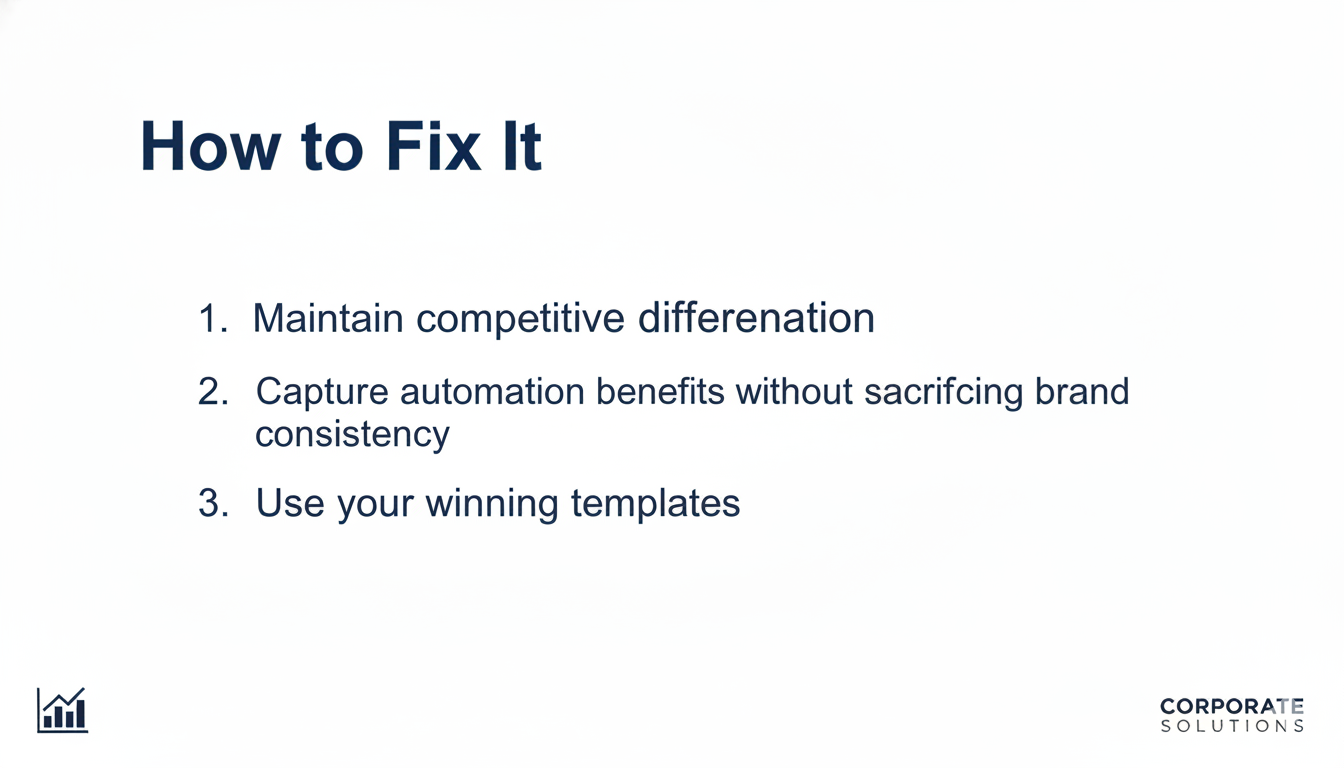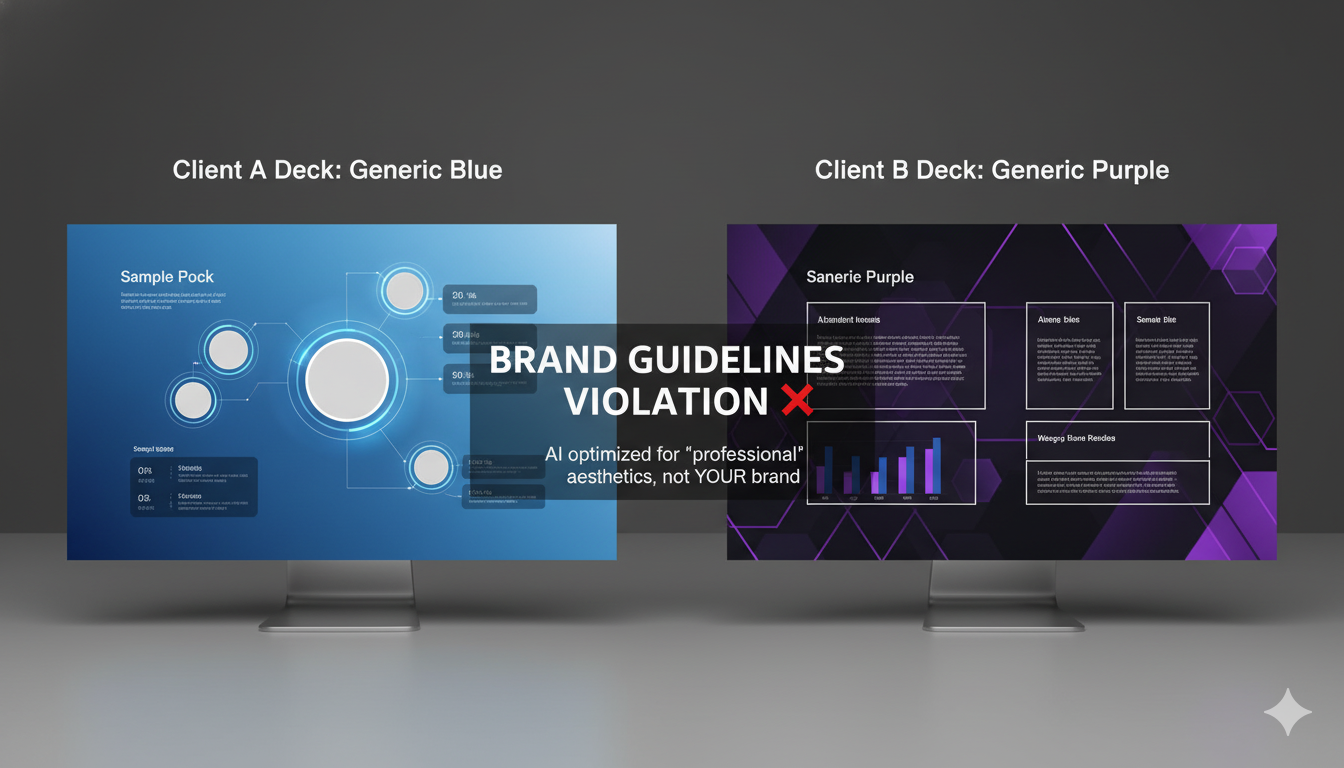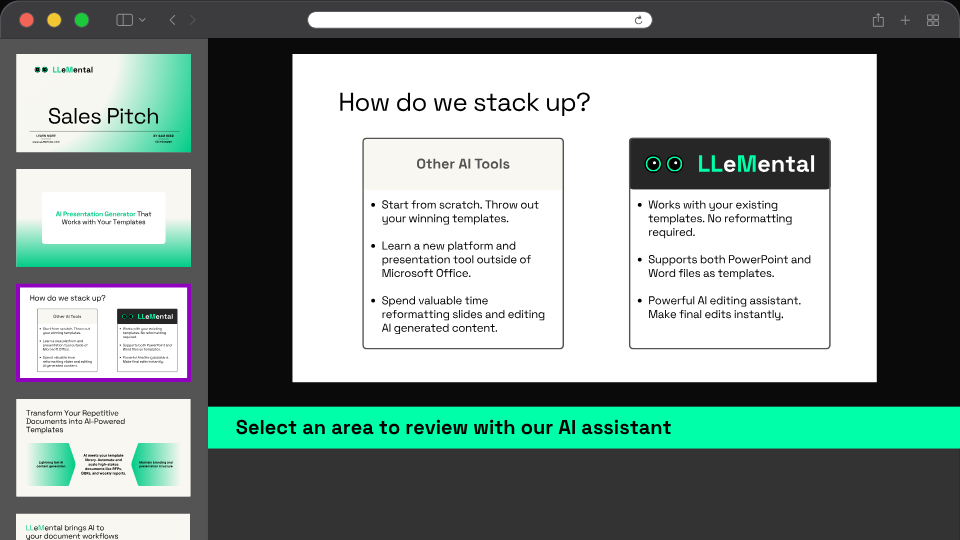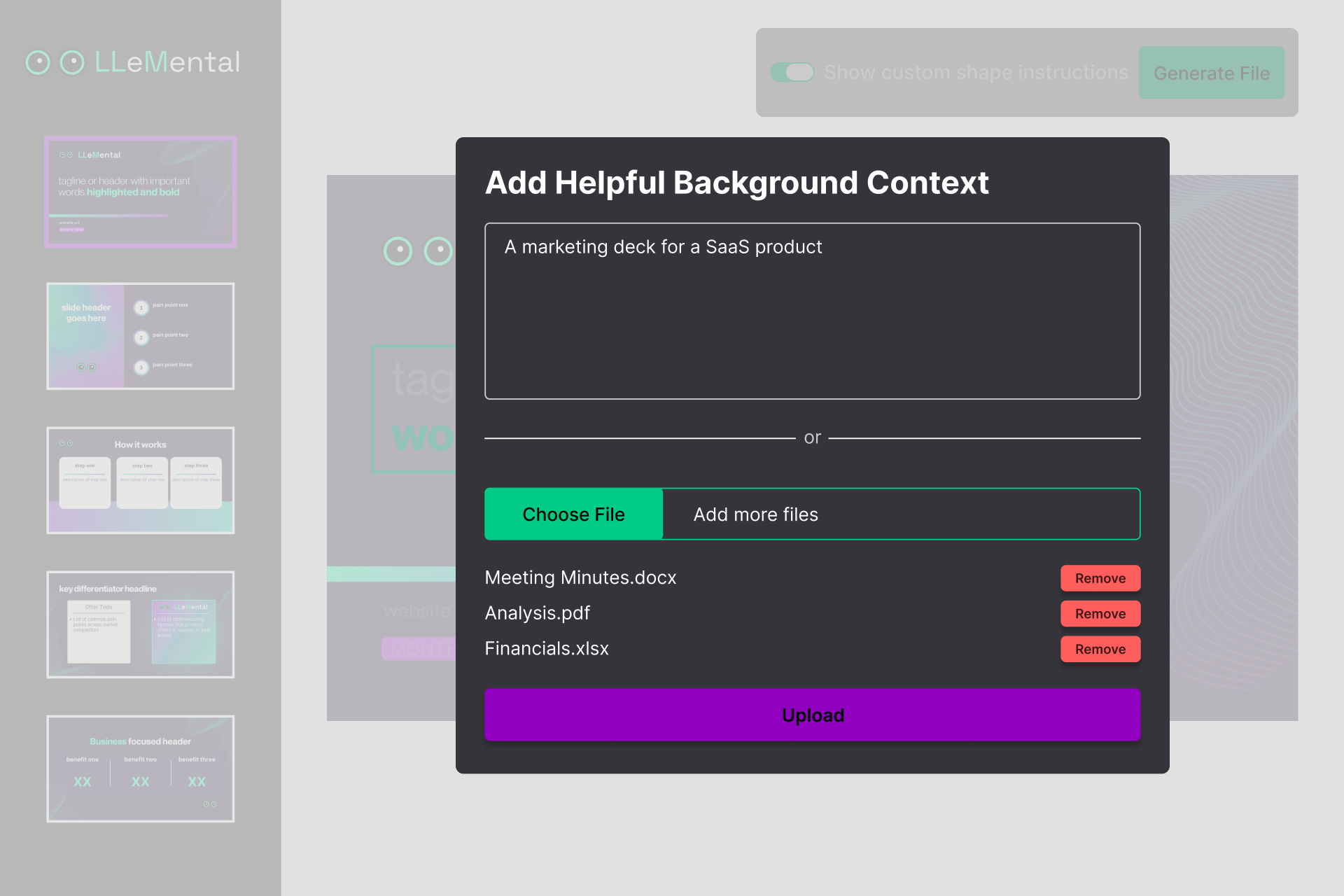2025-11-15
Why Your AI Presentations Look AI-Generated (And How to Fix It)
The real reason AI-generated presentations feel generic—and how template preservation solves the authenticity problem

There’s a problem with AI-generated presentations that nobody wants to talk about: they look like AI-generated presentations.
You know the telltale signs. The overly polished gradients. The generic stock imagery. The suspiciously perfect color palettes that match no brand guidelines you’ve ever seen. The bullet points that sound like they were written by someone who learned business English from a textbook.
According to MIT research on AI implementation, 95% of AI pilot programs fail—not because the technology doesn’t work, but because the output doesn’t fit existing business workflows. When it comes to presentations, this disconnect manifests as a fundamental authenticity problem that undermines the very purpose of automation: saving time while maintaining professional credibility.
The issue isn’t that AI can’t create presentations. The issue is that most AI presentation tools force you to abandon the templates, branding, and design standards that make your presentations recognizably yours. To understand the full scope of how AI presentation technology is evolving and why template preservation represents the solution to this authenticity crisis, explore our comprehensive guide to AI presentation automation with complete template preservation.
The Tell-Tale Signs of AI-Generated Presentations
Generic Template Aesthetics
Most AI presentation makers work by generating new slides from scratch. They pull from libraries of pre-designed templates optimized for visual appeal rather than brand alignment. The result? Presentations that look professionally designed but completely foreign to your organization’s visual identity.
The problem compounds when you need to create multiple presentations. Each generation might pull different template variations, creating inconsistency across your presentation library. One client pitch deck has blue gradients and circular graphics. The next uses purple accents and geometric patterns. Nothing matches your brand guidelines because the AI is optimizing for generic “professional” aesthetics rather than your specific brand identity.

Formulaic Content Structure
AI content generation follows patterns. When an AI presentation maker generates content from scratch, it relies on training data that teaches it what “good” presentations look like in aggregate. The output tends toward the middle: safe, professional, and utterly predictable.
You see this in content structure that feels manufactured. Introduction slides that always follow the same pattern. Three bullet points per slide regardless of content complexity. Conclusion slides that summarize in exactly the same format every time. The AI isn’t wrong—these patterns do appear in many successful presentations. But they also create a sameness that makes presentations feel template-generated rather than strategically crafted.
Disconnection from Existing Brand Assets
Perhaps the most damaging authenticity issue: AI-generated presentations require abandoning your existing templates. Organizations invest thousands of dollars and hundreds of hours developing PowerPoint templates that reflect brand standards, legal requirements, and design refinement. Marketing agencies have proposal templates that win clients. Investment firms have pitchbook formats that drive decisions. Consulting practices have methodology presentations that demonstrate expertise.
Standard AI presentation tools force you to start over. Upload your brand guidelines and hope the AI approximates your look. Manually adjust generated slides to match your standards. Accept close-enough aesthetics because exact replication isn’t possible.
This creates a devastating choice: use AI and lose brand consistency, or maintain brand standards and lose automation benefits.
Why Template Generation Creates Authenticity Problems
Understanding why AI-generated presentations feel inauthentic requires examining how most AI presentation tools actually work.
The “From Scratch” Approach
Most AI presentation makers follow a generation model. You provide content, select a template style from their library, and the AI creates new slides based on those inputs. The technology is impressive: natural language processing analyzes your content, determines appropriate visual structures, and assembles slides that present information logically.
But this approach has an inherent limitation. The AI is creating something new rather than enhancing something existing. It’s optimizing for general presentation best practices rather than your specific presentation standards. The result looks professional by generic standards but fails to capture the distinctive elements that make your presentations authentically yours.
Consider what gets lost in this translation. Your carefully crafted slide master configurations. The specific font pairing that took your design team weeks to perfect. The exact shade of blue that matches your brand palette. The footer layout that includes required legal disclaimers. The spacing and alignment choices that create visual consistency across hundreds of presentations.
These details seem minor individually. Collectively, they constitute your brand’s visual identity—the elements that make your presentations immediately recognizable to clients and prospects.
AI Optimization for Generic “Professional” Aesthetics
AI presentation tools train on vast libraries of presentations to learn what makes slides effective. This training creates an averaging effect. The AI learns that most professional presentations use certain color combinations, specific layout patterns, and particular content structures. When generating new presentations, it gravitates toward these averaged patterns.
The problem? Your organization isn’t average. Your brand has specific characteristics that differentiate you from competitors. Your presentations serve particular purposes that may not align with generic best practices. Your industry may have conventions that differ from cross-industry averages.
When AI optimizes for generic professionalism, it creates presentations that could belong to any organization. The distinctive elements that signal your brand’s personality disappear in favor of broadly appealing but ultimately forgettable design choices.

The Loss of Presentation Equity
Organizations build presentation equity over time. A marketing agency develops proposal templates that consistently win competitive pitches. A consulting firm refines methodology presentations that effectively communicate complex strategies. An investment bank creates pitchbook formats that drive decision-making conversations.
This equity represents real business value. It’s not just about looking good—it’s about communication effectiveness proven through repeated use. When you abandon these templates for AI-generated alternatives, you’re not just losing design assets. You’re abandoning communication frameworks that work.
The business impact extends beyond aesthetics. Teams lose confidence in AI tools when outputs require extensive manual adjustment to meet brand standards. The promised time savings disappear when professionals spend hours reformatting AI-generated slides. Adoption resistance builds as users compare AI outputs unfavorably to familiar templates they trust.
How Template Preservation Solves the Authenticity Problem
There’s a different technological approach that addresses authenticity issues at their source: instead of generating new presentations, enhance your existing templates with AI capability.
Working With Rather Than Replacing Templates
Template preservation technology represents a fundamental shift in how AI presentation automation works. Rather than forcing migration to new template systems, it adds intelligent content generation to your existing PowerPoint and Word files.
The process preserves everything that makes your templates distinctively yours. Your slide masters remain intact. Your fonts, colors, and spacing stay exactly as designed. Your brand guidelines continue to be followed perfectly because the templates enforcing those guidelines aren’t changing—they’re just gaining AI-powered content automation.
This approach aligns with the MIT research finding that successful AI implementations “integrate deeply and adapt over time” rather than requiring organizational adaptation to new systems. You’re not asking your team to learn new presentation formats or abandon familiar workflows. You’re enhancing tools they already know how to use. Our detailed analysis of AI PowerPoint automation best practices demonstrates how this integration approach overcomes the adoption barriers that cause most AI implementations to fail.
Automatic Configuration: AI That Understands Your Templates
LLeMental takes a fundamentally different approach than other AI presentation tools. While competitors force you to rebuild presentations in their systems, LLeMental’s breakthrough technology automatically analyzes your uploaded PowerPoint and Word templates to identify which sections should be dynamic versus static. This automatic configuration means you can start generating presentations immediately without manual setup—no template migration, no rebuilding, no workflow disruption.
The AI recognizes patterns in your templates: title slides with client names that change per project, methodology sections that remain consistent, case study areas that need customization. It understands document structure well enough to make intelligent decisions about what should be automated and what should remain untouched.
For users who want granular control, LLeMental also offers optional prompt configuration. Click on any text area and provide specific instructions for how AI should generate content for that section. This combination of automatic intelligence with optional customization provides both speed and precision. The key advantage: your templates maintain their exact formatting, branding, and structure while gaining powerful automation capabilities. This template preservation capability is unique to LLeMental—no other platform can work directly with your existing files without forcing template reconstruction.
Multi-Source Intelligence, Not Template Filling
LLeMental’s approach goes far beyond simple placeholder replacement. The platform processes multiple document formats simultaneously—meeting notes, research reports, spreadsheets, websites—and synthesizes information into coherent narratives that match your template structure.
This distinction matters for authenticity. Generic AI presentation makers optimize for quick generation from simple prompts, creating surface-level content that feels manufactured. LLeMental optimizes for intelligent content synthesis that matches your organization’s communication style and strategic approach while maintaining your proven template structure.
Consider a marketing agency creating a client proposal using LLeMental. The platform processes the client’s website for background information, analyzes competitive research documents for market context, incorporates previous meeting notes for strategic insights, and pulls relevant case studies from the agency’s library. It then generates content that follows the agency’s proven proposal template structure while demonstrating strategic thinking specific to this client’s situation.
The result feels authentic because it is authentic—it’s your template structure filled with intelligently synthesized content rather than a generic template populated with surface-level information. Only LLeMental combines template preservation with multi-source content synthesis, enabling truly professional outputs that maintain your brand identity while demonstrating strategic depth.

The Business Impact of Natural-Looking AI Content
The authenticity problem isn’t just aesthetic. It has measurable business implications that affect adoption, efficiency, and competitive positioning.
Eliminating Post-Generation Cleanup Time
When AI-generated presentations require extensive reformatting to meet brand standards, the promised time savings disappear. Research shows that 40% of PowerPoint creation time is wasted on formatting and design inconsistencies—representing eight hours monthly per employee lost to non-strategic activities.
Template preservation technology eliminates this waste entirely. Generated presentations emerge in your exact format, requiring no reformatting or brand compliance checking. What takes 2 hours manually takes under 5 minutes with template preservation—actual time savings rather than theoretical efficiency gains that evaporate during quality assurance review.
Building Team Confidence in AI Tools
Adoption resistance represents one of the primary reasons AI implementations fail. When professionals compare AI outputs to trusted templates and find them lacking, they revert to manual creation methods regardless of management directives.
Template preservation technology removes this resistance by working within familiar frameworks. Your team doesn’t need to trust that AI can create good presentations—they already trust their templates. They just need to see that AI can intelligently populate those templates, which is a much smaller confidence gap to bridge.
This psychological advantage accelerates adoption and ensures that automation benefits actually materialize rather than remaining unrealized potential. For organizations creating high-volume business documents like proposals and RFP responses, this confidence factor becomes even more critical—learn how agencies are streamlining proposal automation while maintaining quality standards through template preservation approaches.
Maintaining Competitive Differentiation
In professional services, presentation quality signals operational capability. When your proposals, pitch decks, and client presentations maintain distinctive branding and demonstrate strategic thinking, you communicate competence before saying a word.
Generic AI-generated presentations undermine this signaling. They communicate that you’re using the same tools as everyone else, creating the same outputs as your competitors. Template preservation technology maintains your competitive differentiation by preserving the distinctive elements that make your presentations recognizably superior.
The speed advantage compounds this benefit. Responding to opportunities within hours rather than days demonstrates operational efficiency that resonates with prospects and clients. But that speed advantage only creates positive impressions when the resulting presentations meet professional quality standards without requiring manual refinement.
Implementing Authentic AI Presentation Automation
For organizations ready to solve the authenticity problem while capturing automation benefits, implementation follows a straightforward path focused on enhancing rather than replacing existing assets.
Assessment: Identifying High-Value Templates
Start by auditing your current template library. Which presentations do you create most frequently? Which formats have proven most effective for winning business or communicating complex information? Which templates represent significant design investment that you want to preserve?
Prioritize templates that combine high usage volume with established effectiveness. A proposal template used weekly that consistently wins competitive pitches represents an ideal candidate. A pitchbook format that facilitates productive client conversations deserves automation enhancement.
This assessment also reveals templates that may benefit from redesign. If certain formats require extensive manual work because they’re poorly structured, template preservation technology can still help—but consider refining the base template first to maximize automation efficiency.
Configuration: Adding AI to Existing Templates
With template preservation technology, configuration is remarkably simple. Upload your PowerPoint or Word file and the AI automatically analyzes it to identify dynamic versus static sections. This automatic configuration enables immediate generation without manual setup.
For users who want more control, optional prompt configuration allows clicking on specific text areas to provide detailed instructions for content generation. This granular control ensures AI generates content that matches your organization’s voice and strategic approach. Our step-by-step guide to using AI with existing PowerPoint templates walks through the complete configuration process with practical examples.
The configuration happens once per template. After initial setup, that template lives in your library permanently, available for unlimited reuse across projects and team members. This one-time investment creates ongoing efficiency gains.
Generation: Creating Client-Ready Presentations in Minutes
Once templates are configured, presentation generation becomes dramatically faster. Upload your project-specific documents—meeting notes, research files, client data—and the AI processes multiple sources simultaneously to generate a complete presentation in your exact template format.
The key advantage: presentations emerge client-ready. No reformatting required. No brand compliance checking needed. No hours of manual slide refinement. Just intelligence content in your proven template structure, ready for review and delivery.
For presentations that need adjustments, integrated AI chat assistance enables targeted edits without regenerating the entire document. Refine language, expand sections, adjust tone—all while maintaining template integrity and visual consistency.
The Future of Authentic AI Presentation Automation
Template preservation technology represents the practical path forward for AI presentation automation because it aligns with how organizations actually work rather than forcing adaptation to new paradigms.
As AI capabilities continue advancing, template preservation will enable even more sophisticated automation while maintaining the brand consistency and professional quality that businesses require. Real-time data integration will allow presentations to automatically update with current performance metrics. Advanced collaboration features will support team workflows with role-based editing and automated compliance checking.
But the fundamental principle remains constant: the best AI tools enhance rather than replace existing business assets. They work within familiar frameworks rather than demanding wholesale workflow transformation. They preserve what works while automating what doesn’t require human creativity.
For organizations tired of choosing between AI efficiency and brand authenticity, template preservation technology eliminates that false choice entirely.
Transform Your Presentations Without Losing Your Brand
The authenticity problem facing AI-generated presentations isn’t inevitable—it’s the result of technological approaches that prioritize generation over preservation. When AI tools work with your existing templates rather than replacing them, you capture automation benefits without sacrificing the brand consistency and professional quality that make presentations effective business tools.
LLeMental’s template preservation technology represents this different approach: AI that enhances rather than replaces, that preserves rather than recreates, that works within your established workflows rather than forcing adaptation to new systems.
Ready to experience AI presentation automation that maintains your brand identity?
Upload your existing PowerPoint or Word templates and discover how template preservation creates natural-looking, brand-consistent presentations in minutes rather than hours.
Start your 14-day free trial and see the difference template preservation makes. No credit card required, no template rebuilding necessary.
Questions about how template preservation works with your specific templates? Contact our team for a personalized demonstration using your actual presentation files.